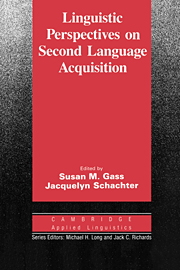Book contents
- Frontmatter
- Contents
- List of contributors
- Series editors' preface
- Introduction
- I THEORIES OF ACQUISITION
- II SYNTAX
- III SEMANTICS/PRAGMATICS
- IV LEXICON
- V PHONOLOGY
- Chapter 11 A constructivist perspective on non-native phonology
- Chapter 12 Stress assignment in interlanguage phonology: an analysis of the stress system of Spanish speakers learning English
- Index
Chapter 11 - A constructivist perspective on non-native phonology
Published online by Cambridge University Press: 05 October 2012
- Frontmatter
- Contents
- List of contributors
- Series editors' preface
- Introduction
- I THEORIES OF ACQUISITION
- II SYNTAX
- III SEMANTICS/PRAGMATICS
- IV LEXICON
- V PHONOLOGY
- Chapter 11 A constructivist perspective on non-native phonology
- Chapter 12 Stress assignment in interlanguage phonology: an analysis of the stress system of Spanish speakers learning English
- Index
Summary
The purpose of this chapter is to argue for a constructivist model of how second language learners acquire phonological competence in a second language. The term constructivist is borrowed from the philosophy of mathematics (see Barker 1964; Bishop 1972; Davis and Hersh 1981). In classical mathematics, functions and other mathematical objects can be defined implicitly. That is, these objects are said to exist if certain conditions have been established even if there are no known procedures involving a finite number of steps through which the objects can be determined. A constructivist approach to mathematics only allows mathematical objects that can be constructed by finite means.
Current accounts of second language phonology cannot be considered constructivist. Instead, they proceed much as does classical mathematics. Once certain facts are established about the native language, the target language, and the actual performance of a learner, then it is simply postulated that a particular phonological representation is justified for the learner. No attempt is made to justify how the learner managed to construct that representation; it is simply assumed to be automatically available and accessible to the learner.
This chapter argues that this point of view is mistaken. There is no phonological representation of a second language that is automatically available to a learner. The learner must construct one. Furthermore, the one he or she constructs may be different from the one constructed by a native speaker of the language.
- Type
- Chapter
- Information
- Linguistic Perspectives on Second Language Acquisition , pp. 243 - 259Publisher: Cambridge University PressPrint publication year: 1989
- 5
- Cited by



